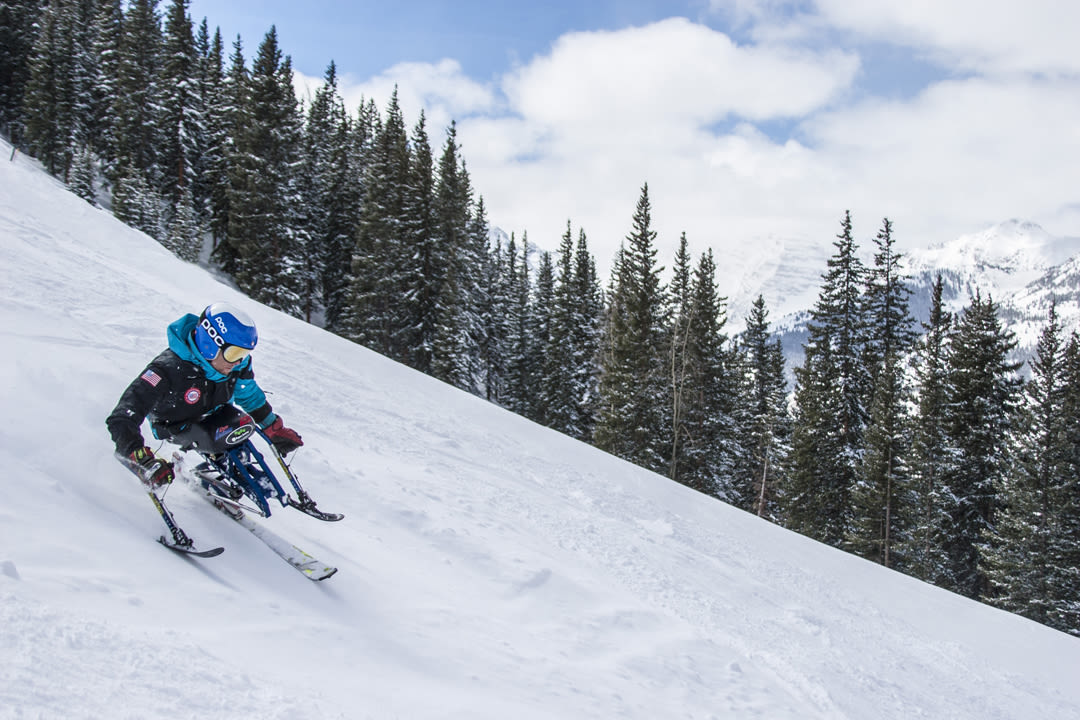Meet the Nation's Top Adaptive Skiers Who Also Call Aspen Home

Image: Bryan Myss
When sit-skier Laurie Stephens is on the hill, it’s easy to see that she’s one hell of a skier. What you likely don’t know is that her results after 16 years of racing place her in the same stratospheric category as Olympic and World Cup champs Mikaela Shiffrin and Ted Ligety. Stephens is the most decorated female International Paralympic Committee (IPC) World Cup skier in US history, and she’s still going strong. She chooses to live and train in Aspen because it has become one of the premier training grounds for the world’s best paralympic snow-sports athletes. She’s far from alone.
Thanks to a unique program, more than half of the US Paralympics national ski and snowboard team members are based here. Developing a world-class training program doesn’t happen in isolation, but the driving vision can be traced to Kevin Jardine. Jardine has coached at the highest levels for 22 years and now works for the US Olympic
Committee as the head coach for the national paralympic alpine ski team, and director of high performance for the national paralympic alpine ski and snowboard teams. In 2006, he moved to the Roaring Fork Valley to organize an IPC World Cup here and to build a competitive paralympic division within Challenge Aspen. As the number of racers grew, the team transferred to the Aspen Valley Ski and Snowboard Club (AVSC).
In 2010, AVSC became the first member club of the US Ski and Snowboard Association to house an internal adaptive program. It has since become one of the most respected in the country. This winter, 18 to 20 skiers will train with AVSC Adaptive, ranging from novice competitors to eight national team members. Additionally, four members of the national snowboard team train within the able-bodied snowboarding program at AVSC. With the option to choose any club in the nation, the fact that more than half of the national team members choose AVSC is a testament to the program’s strength.
AVSC Adaptive is a development program that ushers many of its athletes to IPC World Cup–level competition. “My job is to find new athletes and train them to a level where, if I’m doing my job well, I’m handing them to the national team as fast as possible,” says Tim Emling, AVSC Adaptive’s development head coach.
The unique opportunity for up-and-coming racers to train alongside World Cup–level skiers is part of the appeal of the club from both sides. “Our development team gets to watch and ski with the best athletes in the country and in the world,” says Emling. “It’s an unbelievable benefit. There is no difference in the amount of effort, attitude, and training that goes into becoming a world-class adaptive athlete and a world-class able-bodied athlete.”
"We're not here racing for hugs." —AVSC Adaptive Coach Tim Emling
Along with Aspen’s ski areas themselves, that collective spirit is another reason AVSC Adaptive attracts such an abnormally high concentration of national team members. “With beginners and elite ski racers training side by side, it challenges all of us to become the best racers we can be,” says Stephens. “It has allowed me to give back to the next generation of adaptive ski racers.”
There’s a human tendency to celebrate the success of these athletes based on the physical disabilities they overcome, often before acknowledging the speeds they reach or their ability to arc a turn with razor precision. That recognition is nice, but from the athletes’ perspective, they’re competitors first, adaptive skiers second. Just as it is for Shiffrin or Ligety, the top priority is to perform well on the racecourse. Or, as Emling bluntly states, “We’re not here racing for hugs.”
“They’re elite athletes, and they train to be the best in the world,” says Jardine. “They’re not skiing to inspire others; they’re skiing to win. The inspiration is just a byproduct of what they can do on the hill.” It makes sense. If half of the able-bodied US Ski Team trained in Aspen, the conversation wouldn’t focus on their bodies; it would focus on their performance and why Aspen is the best place to challenge it.
To see these top athletes in action this winter, check out their competition schedule or watch them train locally at the Stapleton Training Center on the Golden Horn and Thunderbowl runs at Aspen Highlands. paralympic.org













































